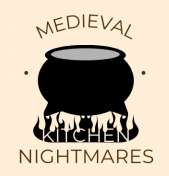This week, I read a really interesting article from the ExArc journal called ‘Killing the Cauldron: Experimental Research on Dented Bronze Cauldrons from the (post)Medieval Period’ by Vincent van Vilsteren.
Vincent van Vilsteren and his cauldrons
For his experiment, he dropped bronze cauldrons on various materials — wooden plank, soft brick, a boulder of quartzite sandstone, iron axeblade, and the back of an iron ax — to compare the resulting damage with those on Medieval vessels. Due to the energy and precision required to create dents and cracks during his experiment, he concluded that the unearthed vessels were used as a form of ritual mutilation (a common practice for other objects such as swords and saddles). He provides the following supporting evidence for this practice (which I found very interesting!)
- Damaged cauldrons could still be recycled and melted down to make new products. Why would people not prioritize reducing costs for future purchases?
- Cauldrons are hardly ever found in middens. Why did past owners not view them as waste?
- Cauldrons are often found in water sources, such as moors, rivers, and wells. Perhaps due to another aspect of a ritual?
- Some cauldrons lacked any evidence of cookware or food residue. Why were they made if not for deliberate deposition?
Overall, his experiment made me reflect on Medieval bronze cauldrons and their cultural significance outside of the kitchen.
A Medieval Kitchen: Il Cuoco Segreto Di Papa Pio V (The Private Chef of Pope Pius V), by Bartolomeo Scappi, Venice, 1570.
Read the article here!!
